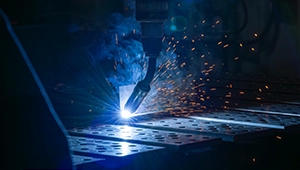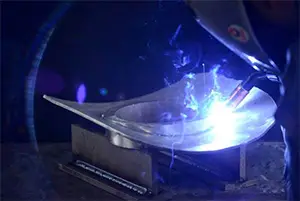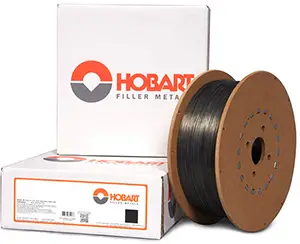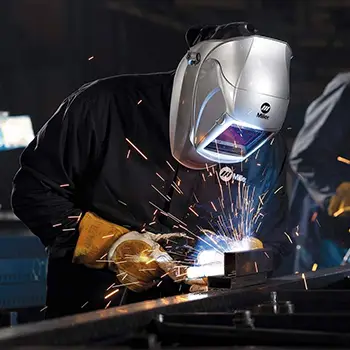The Right Mix: The benefits of putting mixed-gas filler metals to work
Originally published in FABshop Magazine Direct.
As every welder knows, one of the key principles of welding involves selecting the right filler metal for the job. The filler metal needs to align with the base metal, the welding process and any mechanical requirements to achieve a strong, high-quality weld. Taking the necessity for the right filler metal a step further, mixed-gas filler metals can offer significant advantages in terms of weldability and versatility. Pairing filler metals with specific mixtures of shielding gases has become an easy yet strategic way to improve versatility, performance and efficiency in various welding applications.
Pairing filler metals with specific mixtures of shielding gases has become an easy yet strategic way to improve versatility, performance and efficiency.
Looking across the industry, the most common shielding gases used are argon, CO2, helium and oxygen. Each gas impacts welding performance differently depending on its individual characteristics.
Argon is a popular choice in a shielding gas mixture for its stability and inert properties (i.e., nonreactive), which help produce a stable arc and cleaner welds.
- CO2 enhances penetration and weld pool fluidity. However, in its pure form it can create a less stable arc and increase spatter depending on the filler metal and welding process.
- Helium provides deep penetration and a high heat input, making it a good choice for thicker, non-ferrous materials.
- Oxygen is a reactive gas that is mostly used in small ratios. When added to an argon mix, it can improve weld pool fluidity, penetration and arc stability. Because it can cause oxidation, oxygen should not be used when welding aluminum, magnesium or copper.
Selecting a mixed-gas filler metal that is made to work seamlessly with a specific mixture of shielding gases can optimize welding performance, achieving high-quality, efficient welds across various applications. Here are some ways that implementing the use of mixed-gas filler metals can help improve welding outcomes.
Better welding

Filler metals and mixed gases can be tailored to specific applications, alloys and thicknesses, allowing welders to adjust parameters such as penetration, bead shape and welding speed. For example, increasing helium content in the mixture can be beneficial for welding thicker sections, while higher argon content is preferred for thinner materials. The ability to adjust different variables reduces the need to keep an extensive inventory of filler metals or gases on hand, knowing that the right combination of the two can achieve a desired effect.
The use of mixed gases with the appropriately classified filler metals can enhance arc stability and reduce spatter, leading to cleaner welds and reduced post-weld cleanup. Improved mechanical properties of the weld, such as tensile strength and toughness, can also be achieved through optimized gas mixtures.
For example, if meeting a specific tensile strength for the weld is necessary, a mixed gas can help form a weld bead that exhibits the desired strength range without having to buy a new or specific welding wire to accommodate the requirement. Typically, as the argon content of the gas mixture is increased, the tensile strength and yield strength rise as well.

Paired with the right gas mixture, mixed-gas filler metals can expand welding speeds, leading to improved productivity. The gas mixture can help maintain consistent heat input to the weld pool, which also helps maintain a stable arc, allowing the welder to maintain a steady travel speed without needing to stop and address arc instability issues. Additionally, welders can experience improved penetration and higher deposition rates, which also increases operational efficiency.
Selecting a filler metal
Unsurprisingly, there is a vast array of mixed-gas filler metals to choose from, and of course, the right selection is going to depend on a handful of key factors. Hobart Welding Products has numerous mixed-gas or gas-shielded products, both in flux-cored and metal-cored, that can meet the needs of myriad applications.
One example is the Triple 7 gas-shielded flux-cored wire. It is an all-position filler metal that excels throughout a range of amperages (150 to 350 amps) for single and multi-pass applications. This range is affected by wire diameter, with smaller diameters having a better low-end amperage and larger diameters having a better high-end amperage.

Triple 7 is optimized using argon-CO2 gas mixes, but it also runs great on 100 percent CO2. This filler metal expands the types of jobs that can be accomplished, maximizing its versatility. More specifically, operators experience the following benefits when using Triple 7:
- Fast-freezing slag. Exceptional weld pool control makes for consistent out-of-position welds.
- Smooth, stable arc. The spray-like arc creates a flat bead profile and a high-quality, aesthetically pleasing weld.
- Minimized risk of hydrogen cracking. The H8 designation ensures a weld deposit with less than 8 ml of hydrogen per 100 g of weldment.
- Boosts throughput and reduces expenses. It minimizes spatter levels, facilitates easy slag removal and simplifies interpass and post-weld cleanup, reducing costly rework caused by slag inclusions.
In choosing a mixed-gas filler metal alongside the right mixture of shielding gases, welding operators can significantly influence weld quality, penetration, arc stability and overall operational efficiency. The versatility and expansive weldability of these filler metals are strategic tools in an operator’s welding toolbox that help achieve optimal results across a wide range of applications and materials.



